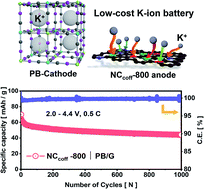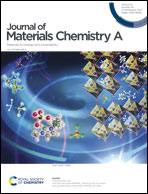A nitrogen-doped amorphous/graphitic hybrid carbon material derived from a sustainable resource for low-cost K-ion battery anodes†
Abstract
Owing to high natural abundance and relatively low redox potential of potassium (K), the K-ion battery (KIB) is a compelling substitute technology for the currently used lithium-ion battery (LIB). In this study, we propose a natural eco-friendly nitrogen (N)-doped porous carbon matrix from waste coffee grounds, which are abundantly available as biomass for KIB anode application. High electrical conduction and effective doping of active N atoms with lone electron pairs can be achieved through simple carbonization. Heteroatom N exists in multiple forms, such as graphitic N, pyridinic N, and pyrrolic N, all of which have lone pair electrons. The NCcoff-800 is optimized mesoporous structure with a good balance of graphitic N and coexistence of amorphous and graphitic carbon, allowing the highly reversible K storage properties to be preserved. To ensure practical utilization of NCcoff-800 as an anode, we assembled K-ion full-cells using a high-voltage Prussian blue/graphene (PB/G) composite as the cathode, which exhibited a high specific capacity of 90 mA h g−1 at 0.1C and long-term cycling stability over 1000 cycles at 0.5C. This study suggests that an affordable, eco-friendly, high-performance practical KIB, providing excellent electrochemical properties, could be developed using an inexpensive anode derived from used coffee grounds together with a PB/G cathode.



 Please wait while we load your content...
Please wait while we load your content...